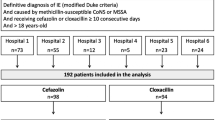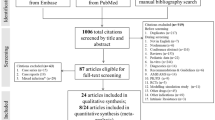Abstract
Methicillin-resistant Staphylococcus aureus is a pathogen that is associated with serious infections that pose a significant risk of morbidity and mortality because of their multidrug resistant nature. Until recently, therapeutic options were limited to vancomycin, making the use of this drug widespread. Unfortunately, the continued application of this drug has led to the emergence of glycopeptide intermediate susceptible S. aureus (GISA). By definition, these organisms demonstrated a vancomycin minimum inhibitory concentration (MIC) of >4 mg/L and <32 mg/L. However, although the mechanism of resistance is not fully elucidated at this time, GISA strains have demonstrated thickened or aggregated cell walls, an increase in penicillin binding proteins and greater autolytic activity. At present, the overall number of reported cases of GISA is relatively low. In most cases, thus far, prolonged courses of vancomycin were reported. A few cases reported monitoring serum vancomycin concentrations but because of limited information, no association with outcome can be made. Whether these GISA strains will become more widespread or evolve into fully glycopeptide resistant strains is unknown at this time. Although there are a number of new agents that possess activity against these pathogens, there is no consensus regarding specific recommendations for treatment. Strict infection control practices, routine screening for resistance and controlled use of antibacterial agents, especially vancomycin, are critical steps in preventing the further development of resistance among staphylococci.

Similar content being viewed by others
References
Sahm DF, Marsilio MK, Piazza G. Antimicrobial resistance in key bloodstream bacterial isolates: electronic surveillance with The Surveillance Network Database — USA. Clin Infect Dis 1999; 29: 259–63
Sabath LD. Mechanisms of resistance to beta-lactam antibiotics in strains of Staphylococcus aureus. Ann Intern Med 1982; 97: 339–44
Watanakunakorn C. Treatment of infections due to methicillin-resistant Staphylococcus aureus. Ann Intern Med 1982; 97: 376–8
Rubin RJ, Harrington CA, Poon A, et al. The economic impact of Staphylococcus aureus infections in New York City Hospitals. Emerg Infect Dis 1999; 5(1): 9–17
Waldvogel FA. Staphylococcus aureus (including toxic shock syndrome). In: Mandell GL, Bennett JE, Dolin R, editors. Mandell, Douglas and Bennett’s principles and practice of infectious diseases. 4th ed. New York (NY): Churchill Livingstone, 1995: 1754–77
Sieradzki K, Villari P, Tomasz A. Decreased susceptibilities to teicoplanin and vancomycin among coagulase-negative methicillin-resistant clinical isolates of staphylococci. Antimicrob Agents Chemother 1998; 42: 100–7
Schwalbe RS, Stapleton JT, Gilligan PH. Emergence of vancomycin resistance in coagulase-negative staphylococci. N Engl J Med 1987; 316(13): 927–31
Smith TL, Pearson ML, Wilcox KR, et al. Emergence of vancomycin resistance in Staphylococcus aureus. N Engl J Med 1999; 340(7): 493–501
Johnson AP. Intermediate vancomycin resistance in Staphylococcus aureus: a major threat or a minor inconvenience? J Antimicrob Chemother 1998; 42: 289–91
Sieradzki K, Roberts RB, Haber SW, et al. The development of vancomycin resistance in a patient with methicillin-resistant Staphylococcus aureus infection. N Engl J Med 1999; 340(7): 517–23
Waldvogel FA. New resistance in Staphylococcus aureus. N Engl J Med 1999; 340(7): 556–7
Edmond MB, Wenzel RP, Pasculle AW. Vancomycin-resistant Staphylococcus aureus: perspectives on measures needed for control. Ann Intern Med 1996; 124: 329–34
Noble WC, Virani Z, Cree RG, et al. Co-transfer of vancomycin and other resistance genes from Enterococcus faecalis NCTC 12201 to Staphylococcus aureus. FEMS Microbiol Lett 1992; 93: 195–8
Hiramatsu K, Aritaka N, Hanaki H, et al. Dissemination in Japanese hospitals of strains of Staphylococcus aureus heterogeneously resistant to vancomycin. Lancet 1997; 350: 1670–3
Interim guidelines for prevention and control of staphylococcal infection associated with reduced susceptibility to vancomycin. Morb Mortal Wkly Rep 1997; 46(27): 626–8, 635
Geisel R, Schmitz FJ, Thomas L, et al. Emergence of heterogeneous intermediate vancomycin resistance in Staphylococcus aureus in the Dusseldorf area. J Antimicrob Chemother 1999; 43: 846–8
Howe RA, Bowker KE, Walsh TR, et al. Vancomycin resistant Staphylococcus aureus. Lancet 1998; 351: 601–2
Marchese A, Balistreri G, Tonoli E, et al. Heterogeneous vancomycin resistance in methicillin-resistant Staphylococcus aureus: strains isolated in a large Italian Hospital. J Clin Microbiol 2000; 38: 866–9
Soares JJ, Dos S, da Silva-Carvalho MC, et al. Spread of methicillin-resistant Staphylococcus aureus belonging to the Brazilian epidemic clone in a general hospital and emergence of heterogeneous resistance to glycopeptide antibiotics among three isolates. J Hosp Infect 2000; 44: 301–8
Reduced susceptibility of staphylococcus to vancomycin: Japan 1996. Morb Mortal Wkly Rep 1997; 46: 624–35
Hiramatsu K, Hanaki H, Yabuta K, et al. Methicillin-resistant Staphylococcus aureus clinical strain with reduced vancomycin susceptibility. J Antimicrob Chemother 1997; 40: 135–6
Hiramatsu K. The emergence of Staphylococcus aureus with reduced susceptibility to vancomycin in Japan. Am J Med 1998; 104(5A): 7S–10
Update: Staphylococcus aureus with reduced susceptibility to vancomycin: United States, 1997. Morb Mortal Wkly Rep 1997; 46(35): 813–15
Ploy MC, Grelaud C, Martin C, et al. First clinical isolate of vancomycin-intermediate Staphylococcus aureus in a French hospital. Lancet 1998; 351: 1212
Rotun SS, McMath V, Schoonmaker DJ, et al. Staphylococcus aureus with reduced susceptibility to vancomycin isolated from a patient with fatal bacteremia. Emerg Infect Dis 1999; 5: 147–9
McManus J. Vancomcycin resistant staphylococcus reported in Hong Kong. BMJ 1999; 318: 626
Tenover FC, Lancaster MV, Hill BC, et al. Characterization of staphylococci with reduced susceptibilities to vancomycin and other glycopeptides. J Clin Microbiol 1998; 36: 1020–7
Hershberger E, Aeschlimann JR, Moldovan T, et al. Evaluation of bactericidal activities of LY333328, vancomycin, teicoplanin, ampicillin-sulbactam, trovafloxacin, and RP59500 alone or in combination with rifampin or gentamicin against different strains of vancomycin-intermediate Staphylococcus aureus by time-kill curve methods. Antimicrob Agents Chemother 1999; 43: 717–21
Akins RL, Rybak MJ. In vitro activities of daptomycin, arbekacin, vancomycin, and gentamicin alone and/or in combination against glycopeptide-intermediate resistant Staphylococcus aureus in an infection model. Antimicrob Chemother 2000; 44: 1925–9
Rybak MJ, Hershberger E, Moldovan T. Comparative in vitro activity of daptomycin versus vancomycin, linezolid, and synercid against methicillin-resistant and susceptible staphylococci, vancomycin-intermediate susceptible Staphylococcus aureus and vancomycin susce [abstract C-146]. Program and abstracts of the 38th Interscience Conference on Antimicrobial Agents and Chemotherapy: 1998 Sep 24–27; San Diego (CA). Washington, DC: American Society for Microbiology, 1998: 110
Hanaki H, Kuwahara-Arai K, Boyle-Vavra S et al. Activated cell-wall synthesis is associated with vancomycin resistance in methicillin-resistant Staphylococcus aureus clinical strains MU3 and MU50. J Antimicrob Chemother 1998; 42: 199–209
Shlaes DM, Shlaes JH, Vincent S, et al. Teicoplanin-resistant Staphylococcus aureus expresses a novel membrane protein and increases expression of penicillin-binding protein 2 complex. Antimicrob Agents Chemother 1993; 37: 2432–7
Milewski WM, Boyle-Vavra S, Moreira B, et al. Overproduction of a 37-kilodalton cytoplasmic protein homologous to NAD+-linked D-lactate dehydrogenase associated with vancomycin resistance in Staphylococcus aureus. Antimicrob Agents Chemother 1996; 40: 166–72
Daum RS, Gupta S, Sabbagh R, et al. Characterization of Staphylococcus aureus isolates with decreased susceptibility to vancomycin and teicoplanin: isolation and purification of a constitutively produced protein associated with decreased susceptibility. J Infect Dis 1992; 166: 1066–72
Aeschlimann JR, Hershberger E, Rybak MJ. Analysis of vancomycin population susceptibility profiles, killing activity, and postantibiotic effect against vancomycin-intermediate Staphylococcus aureus. Antimicrob Agents Chemother 1999; 43: 1914–18
Boyle-Vavra S, Berke SK, Lee JC, et al. Reversion of glycopeptide intermediate-resistant Staphylococcus aureus associated with loss of type 5 capsule [session 147. C1 paper 1455]. Program and abstracts of the 39th Interscience Conference on Antimicrobial Agents and Chemotherapy: 1999 Sep 26–29; San Francisco (CA). Washington, DC: American Society for Microbiology, 1999: 132
Aeschlimann JR, Hershberger E, Rybak MJ. Activity of vancomycin administered every 12 hours or as continuous infusion against two clinical strains of vancomycin-intermediate Staphylococcus aureus in an in vitro pharmacodynamic model [abstract A-10]. Program and abstracts of the 38th Interscience Conference on Antimicrobial Agents and Chemotherapy: 1998 Sep 24–27; San Diego (CA). Washington, DC: American Society for Microbiology, 1998: 3
Dudley M, Griffith D, Corcoran E, et al. Pharmacokinetic-pharmacodynamic indices for vancomycin treatment of susceptible and intermediate S. aureus in the neutropenic mouse thigh model [session 198 paper 2031]. Program and abstracts of the 39th Interscience Conference on Antimicrobial Agents and Chemotherapy: 1999 Sep 26–29; San Francisco (CA). Washington, DC: American Society for Microbiology, 1999: 49
Aeschlimann JR, Hershberger E, Rybak MJ. Activity of LY333328, an investigational glycopeptide, against three strains of vancomycin-intermediate Staphylococcus aureus in an in vitro pharmacodynamic infection model [abstract A-135]. Program and abstracts of the 38th Interscience Conference on Antimicrobial Agents and Chemotherapy: 1998 Sep 24–27; San Diego (CA). Washington, DC: American Society for Microbiology, 1998:43
Sieradzki K, Tomasz A. Inhibition of cell wall turnover and autolysis by vancomycin in a highly vancomycin-resistant mutant of Staphylococcus aureus. J Bacteriol 1997; 179: 2557–66
Sieradzki K, Tomasz A. Suppression of beta-lactam antibiotic resistance in a methicillin-resistant Staphylococcus aureus through synergic action of early cell wall inhibitors and some other antibiotics. J Antimicrob Chemother 1997; 39: Suppl. A: 47–51
Aeschlimann JR, Hershberger E, Rybak MJ. Pharmacodynamic predictors of activity for ampicillin/sulbactam and trovafloxacin versus vancomycin-intermediate Staphylococcus aureus in an in vitro infection model [abstract A-38]. Program and abstracts of the 38th Interscience Conference on Antimicrobial Agents and Chemotherapy: 1998 Sep 24–27; San Diego (CA). Washington, DC: American Society for Microbiology, 1998: 12
Author information
Authors and Affiliations
Corresponding author
Rights and permissions
About this article
Cite this article
Rybak, M.J., Akins, R.L. Emergence of Methicillin-Resistant Staphylococcus aureus with Intermediate Glycopeptide Resistance. Drugs 61, 1–7 (2001). https://doi.org/10.2165/00003495-200161010-00001
Published:
Issue Date:
DOI: https://doi.org/10.2165/00003495-200161010-00001




